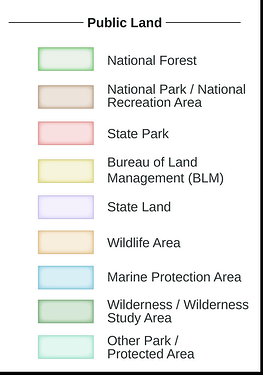Long post ahead, fair warning.
Thanks for the mention, Brian @ZeLonewolf, though it has been many more than simply you and I who have endeavored to develop and improve the Public Lands wiki over the years. This topic is something I have striven to better express in OSM (both in the map and in that and other wikis) for nearly the entire 14+ years I’ve been a Contributor to Our Fine Project (OFP=OSM!)
Speaking colloquially about the USA here and now, that Public Lands wiki goes a certain distance to explaining that there is a highly complex fabric of “public lands” in many thousands of jurisdictions (federal, state, county, municipal / local, even private homeowners associations where the land might be “permissive” by the owners, sort of “quasi-public,” but is actually private). It is deeply complex because of the various agencies even within the federal government alone, maybe if you add in state governments (as evidenced by the “Public Land” legend of Gaia Topo referenced by @ezekielf; thanks Zeke): in any given “area,” one might find “public lands” administered by no fewer than four jurisdictions and from many multiple agencies — maybe even several of them all federal!
All that said, to answer OP’s original question, I believe that OSM does presently have a “rough framework” in our data of the distinctions (at least at the federal level) of National Park, National Forest, and so on and at the state level. This gets better state-by-state, but this is slow going. OSM will need to better articulate (in that Public Lands wiki) how we do (descriptive) and should (prescriptive) tag these entities (at a state level, especially). THEN, renderers (if they choose to do so) can display these, but we continue to contend with age-old issue of “getting the correct, agreed-upon data taggings into the map itself, FIRST.” We must describe what these ARE (DEscriptive tagging at the federal level, that wiki does an OK job of it, but state-by-state we need much more effort) and we should (imo) describe what these SHOULD be (prescriptive tagging) on an ongoing basis. We only have a handful of states in that wiki now, but long journeys begin with the first steps.
As we do come closer to completion of both federal de-/pre- -scriptive tagging in both all 50 states and at the federal level, downstream, end-use cases (like routers as the OP asks, overlays, OT queries, renderers — yes, Americana keeps doing a better and better job of rendering AND displaying a “live legend” of these)…it will get better and better. But we do have a fair bit of work to do: the concept of boundary=protected_area as a (sort of “naked” tag) was something Brian and I worked on as a semantic exercise over the course of many months. It was like a puzzle we had to unravel, and it turned into a joint proposal by both of us, Proposal:Park boundary - OpenStreetMap Wiki . What this does is strip down ANY “protected area” to its essential core (what we “figured out” semantically makes sense) as a boundary=protected_area tag, then “builds it back up” as a more-complete (and in the case of some “parks” or whatever it might be), and in some cases “more complex” park "entity.
For example, it could be that the “front country” of the “park” has commonly-used amenities like viewscapes / wildlife observation, shorter, easier “nature hikes,” restrooms and/or concessions, easy parking, a visitor center, et cetera. The “back country” of the “park” might have little more than wilderness trails, primitive campgrounds and virtually no other services, but caters to intrepid backpackers (or maybe mountain bikers), for example, those who know how to carry their own water/food, clean socks and a tent and sleeping bag.
How OSM displays / renders these, or allows routing on these (obviously) requires good tagging, but that in turn requires agreement among (again, I’m USA-specific here…maybe in your country you do something similar) OSM’s contributors that we “tag correctly.” I believe we are on our way to doing so. This is evidenced in better-tagged areas “nicely” displaying in Americana and Gaia Topo (correctly tagged) as they do. But we have much more work to do, especially at the state-by-state level (as seen in the rather sparse table of the Public Lands wiki).
In short (too late), “this gets better,” but it depends on a really strong foundation of agreement / consensus on how we should tag Public Lands. We’re in earlier-to-middle stages of this (imo), but we need to keep building both our consensus and our map’s data. THEN, we can “route” (or render…) more and more accurate Public Lands. I realize much of this seems obvious, but it doesn’t hurt to take a snapshot of how our “slow moving database” continues to grow, and become more and more correct, though rather slowly. We’re getting there. Good dialog really does help.
(I’m largely leaving out how the widely-encompassing word/concept of “park” in US English rather badly conflicts with the OSM-specific quite narrow definition of leisure=park. OSM had contentious semantic unraveling of that in 2018-19, and I think we got it largely understood and documented in our various wikis).
Thank you for reading.
